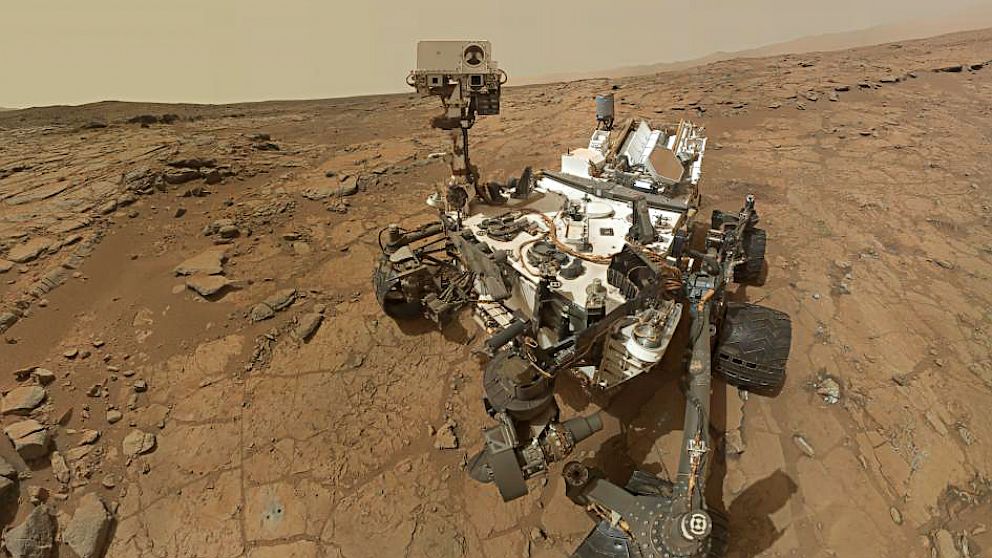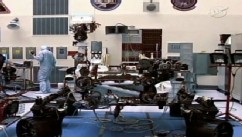
Curiosity Reveals That Mars Is Losing Its Atmosphere
Jon M. Chang

The Mars rover Curiosity is doing more than channeling its inner tourist and snapping photos every chance it gets. Two new papers appearing in this week's issue of Science are the first to come out of the Mars Science Laboratory that talk about the planet's surface. Both papers say that Mars has been steadily losing its atmosphere over the past 4 billion years.
This isn't the first time that NASA has measured the concentration of gases in the Martian atmosphere. "There was really groundbreaking work back in the '70s with the Viking landers," Paul Mahaffy, the lead author behind one of the papers and a NASA scientist, told ABC News. "But those landers were a more primitive version of the thing that's landed on Mars now."
Curiosity measures gas directly from the atmosphere, as well as gases released from solids, using two different instruments that are a part of SAM (Sample Analysis on Mars). Specifically, they are calculating the ratios of different isotopes, elements that have the same number of protons, but differ in weight.
Heavier isotopes are usually rarer in nature than lighter ones, but Mars is showing a higher ratio than what you would see on Earth. The higher the ratio, the more atmospheric loss that is occurring. "When you look at the physics of how atoms escape from an atmosphere, the lighter atoms can escape a little easier," said Mahaffy. "It's not a big effect, but if the molecules are lost over billions of years, you start to build up more of the heavy isotopes."
This accumulation of heavier isotopes, or isotopic enrichment, is prominent when looking at the levels of hydrogen in the Martian atmosphere. Curiosity found much more deuterium, a heavier isotope of hydrogen, than what you would see on Earth. "The ratio is about five times higher," said Chris Webster, the lead investigator behind the Tunable Laser Spectrometer, one of SAM's instruments.
"The ratio of deuterium to hydrogen is one of the fundamental measurements of any object in the solar system," said Webster. Scientists had created a model that explained the ratios on many objects, but Mars threw a wrench into that model. "You go to Mars and then say, 'What the heck?'"
One of the leading theories explaning this abnormality is a Pluto-sized object that rammed into Mars about four and a half billion years ago. The collision disrupted the planet's magnetic field, which in turn led to an abrupt loss of the planet's atmosphere. Following that abrupt loss, Mars has been slowly, but surely, losing its atmosphere to space. "The data we have doesn't prove this," said Webster. "But it does fall in line with the theory."
The measurements obtained with Curiosity's instruments match up with what's been predicted by both the Viking landers and Martian meteorite studies. Adam Burrows, a professor of astrophysical sciences at Princeton University in New Jersey, says that its the SAM's precision that makes these new findings stand out. "The Viking measurements were very crude. Now, measuring with two different instruments, we get a pretty consistent picture saying that there's been isotopic enrichment," he said.
However, these measurements are not enough to give a complete picture. Burrows wants to see what Curiosity measures both throughout the planet and throughout the Martian year (almost twice as long as an Earth year). "These ratios change a fair amount from place to place and season to season," he says. "But it is the best data we've gotten from another world."
Mahaffy agrees that more measurements need to be collected, but thinks that another satellite will be up to the task. The MAVEN spacecraft (Mars Atmosphere and Volatile EvolutioN) will directly measure the rate of atmospheric loss on the red planet. "It's set to launch this November, though it'll reach Mars much later."
VIEW THE VIDEO
http://abcnews.go.com/Technology/curiosity-reveals-mars-losing-atmosphere/story?id=19701439



